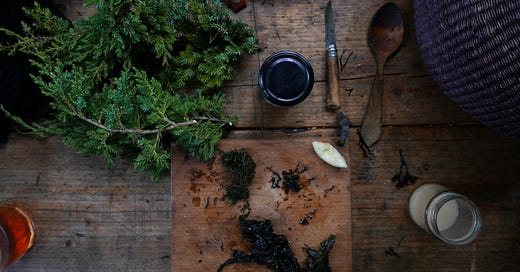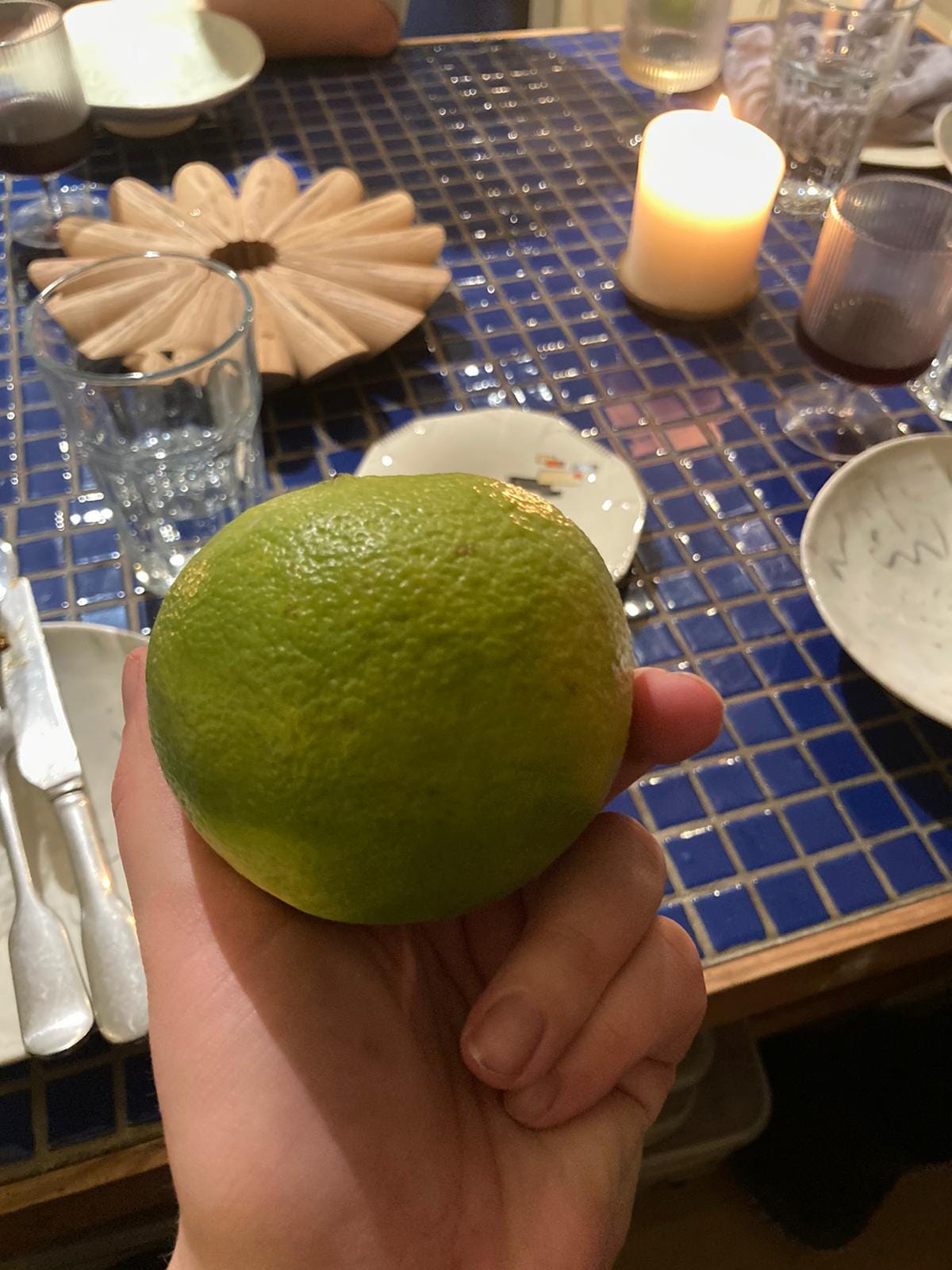Welcome to the Ómós Digest. This newsletter will hopefully bring you on that journey about the food you were looking for, or perhaps never knew existed. It is our quest to expand on what we don’t know and to share with those who care. If you haven’t read Newsletter #1 yet, it can be found here.
It’s March, and as we welcome the new aromas of spring, we take a look at the fragrance industry and how it has affected our sense of taste and smell. This newsletter is brought to you by Cúán Greene, Founder of Ómós.
Indigo & Cloth is a shop that stands out in Dublin. The store itself is dressed to the nines but in a cool, understated Scandinavian way. It’s a shop that dares to be different, offering contemporary menswear, lifestyle goods, and homeware that is otherwise near impossible to find in the city. Speaking with its owner, Andy Collins (a fashion-obsessed, food-loving pal of mine), it’s obvious the gravity he places on the customer journey. There’s a sense of comfort when you enter the shop. In a way, it reminds me of the intimate experience of dining at a high-end restaurant. Personally speaking, this commitment to almost nurture a guest is an area of hospitality I adore. It appears that the same applies to Andy. From the first welcome, you immediately sense a feeling of being cared for. According to him, people are naturally drawn to this feeling of care, and it’s undoubtedly prioritised in his retail setting.
Just as fine dining is not solely about the food, to Andy, when guests enter his shop it’s an opportunity to offer an immersive experience. Fragrant incense, distinctive room sprays, atmospheric candles and even the smell of freshly roasted coffee create a unique scent experience that invites visitors to decelerate. Such smells help us ease into a situation. They are significant in providing memorable experiences.
Recently, Andy and I were chatting about HAY, a Danish design company, that produces a dish wash soap infused with juniper wood. You may already know that ingredients such as juniper, bergamot, yuzu, and geranium are applied in the skincare industry in the form of botanical extracts. When it comes to the use of botanicals, Aesop is a brand that perfectly encapsulates this sensory experience within skincare. I’m drawn to the beautifully minimalist packaging and seduced by the unique fragrances and fresh aromas - a far cry from the intoxicating concoctions inhaled when smothered by our grandmother’s kisses. What captivates me most about Aesop is the collection of ingredients that headline their products: ingredients I use in my culinary larder. Many of these ingredients are significant in our cultural identity, from the most ancient cocktails and antidotes carrying medicinal properties and health benefits. While the use of natural extracts as remedies has evolved over time, our knowledge on how to apply these ingredients to cooking has only faded. What’s even more astonishing is that the vast majority of these products grow wild here in Ireland. From a culinary perspective, their pronounced flavours and distinctive attributes are what define my slightly unconventional cooking style.
In a recent online seminar led by MAD, Gastronomist Harold McGee stated that we have built a deodorised environment, and that we now move in a deodorised society masked by the fragrance industry. For instance, back when dinner parties were a thing, I recall a friend of mine realising that bergamot was a citrus. Utterly astounded by the fact that bergamot was a fruit and not soap, she immediately took a photo of the beautiful green citrus in the salad before her and sent it to her mother. She continued to gaze at the fragrant fruit as if it were the golden snitch, capable of taking flight! While I sit here sipping earl grey tea, which is made using black tea and bergamot oil or zest, I do not taste ‘soapiness’. For me, life is an education of taste and smell, however, I wonder has the skincare industry irreversibly ruined the flavour of such botanicals for others?
While lavender and orange blossom are ingredients you want to be wary of, when used correctly and in moderation, perhaps they still have the ability to transform dishes? One of my responsibilities when cooking in Mexico was to blend fresh avocado leaves into grapeseed oil, with a touch of fresh parsley, until barely emulsified, producing a vibrant green oil. The oil was then transformed into an irresistible pomade with the help of a little butter, kelp seaweed salt, and fresh gooseberry tamari. Although you may be thinking that this would do great on the shelves at L’Occitane, we served it drizzled over slowly grilled Oaxacan pumpkin and native purslane. A triumph.
I don’t doubt that juniper is lovely in soap, but it also has many culinary uses. Growing wild predominantly on the West Coast of Ireland, the branches emit a beautifully sweet flavour when used for smoking fish. Put a couple of hot embers in a metal bucket or suitable box and scatter over a couple of juniper branches. It will begin to smoke. Place your fillets of seasoned fish on a wire rack (chicken-wire has proven useful) and set the rack on top of the smoking branches. Find a suitable lid and allow the fish to smoke for 20 minutes, depending on the size of the fish and the intensity of your heat (when the fish begins to gently flake, you know it is ready). If the fire goes out, just add a couple more embers beneath the branches, hot from your nearby fire. This is best done outdoors.
You can also make an aromatic oil using juniper wood or dried juniper berries (of which I’ve included instructions for below). Juniper oil is perfect when brushed on slices of thinly cured charcuterie or cold-smoked fish, such as Sally Barnes’ tuna or mackerel from her very special Woodcock Smokery. I also use the oil during the summertime as a dressing for berries tossed in lemon balm sugar - another hardy herb native to Ireland, often used in the skincare industry.
Botanical Encyclopedia:
Juniper - One of the few conifer trees or shrubs native to Ireland. It’s low growing and is found predominantly on the West Coast, Co. Tipperary and Co. Donegal and produces little blue/purple berries. If someone knows of any growing wild on the East coast, please let me know.
Rose geranium - Rose geranium grows both in and outdoors. Both the flowers and leaves have the aroma of rose and can be used to make syrups, kombuchas, and other various infusions.
Rosehips - The fruit of the wild rose. Rosehips develop after the petals have fallen and matured into edible fruit. The dog rose (rosa canina) and beach rose (rosa rugosa) are found in the wild in Ireland, close to the shore. For maximum flavour, they are best harvested after the first frost. You can make syrups, jams and pastes from the hips. At Noma, we once made a vegetarian salami, blending the flesh with fermented plums and paprika before drying it like a sausage.
Parsley seed - Also known as wild chervil or cow parsley, it grows wild in Ireland and is commonly found along grassy footpaths. The flowers and leaves can be eaten and so too can the seeds. Flowering in early May, you can eat the stalk, flowers, and later the seeds, but if harvesting, make sure you are certain that it is cow parsley, as similar poisonous species exist.
Lemon balm (melissa officinalis) - Lemon balm grows exceptionally well in Ireland. It is grown for its strong lemon scent and flavour. It’s delicious steeped in water as a tea or macerated into cocktails. Another alternative is briefly blending fresh lemon balm with caster sugar. The result is a sugar with the floral flavour of Menton lemon, minus the mouth-puckering acidity of citrus.
Bergamot - A citrus originating from South East Asia. There is now a huge bergamot industry in Calabria, Italy, growing organic citrus of a very high quality due to the region’s unique terroir and microclimate. The natural essential oil is extracted from the peel by a cold-pressing procedure. “Pastazzo”, which is constituted by pulp and peel of the fruits, and obtained after the extraction process of the essence, is a good soil improver. The Fumbally in Dublin stock fresh organic bergamot when in season (harvesting typically commences in November and ends in March). Try bergamot made into jams; the zest and juice in marinades; or the peel dried and blended into aromatic powders.
Yuzu - Like bergamot, yuzu is a citrus, rough-skinned, and yellow-orange in colour. It is thought to have come from China, although cultivated now in the southern prefectures of Japan. The New Yorker’s Helen Rosner perfectly writes “The knobbly-skinned Japanese fruits are among the most exquisite members of the citrus family: more floral than an orange and nearly as tart as a lime, with a scent that is dense and disarming, the Froot-Loops-y honey of a lemon blossom wrapped around an astringent armature of industrial floor cleaner (which is somehow exquisite), then magnified tenfold, then mailed to the moon.” As far as using yuzu for culinary purposes, you get very little juice from the fruit, so it should be used preciously (like all citrus should be). The zest is beautifully fragrant and is best harvested using one of these wonderful Tsuboe Japanese copper graters.
If you are looking to source wonderful citrus from Europe, click here.
JUNIPER OIL
Makes approx. 350g
100 g juniper berries
400 g grapeseed oil or any neutral oil
Toast the juniper berries in a pan until the aroma is released. It will take approximately 4 minutes.
Place them in a blender or Thermomix with the oil for 8 minutes. The juniper will have broken up by this point and the natural oil will have been emulsified with the grapeseed oil.
Leave to infuse overnight in a sealed vacuum bag or container. You can strain it immediately but the flavour won’t be as pronounced.
Strain through a muslin-lined sieve or strainer. You can use the oil straight away or place it in the fridge for up to 1 week. Alternatively, the oil will retain its flavour very well when kept in the freezer for up to 3 months.
Cooking with these types of ingredients is what gets us going. Please let us know if these are the recipes and processes you would like to learn, and if not, what tickles your fancy? Send us an email or drop us a note in the comments.
Next week’s newsletter will feature an exciting recipe we think you’ll want to try! It will be for paid subscribers only, so if you would like to receive it in your inbox, please subscribe below.







